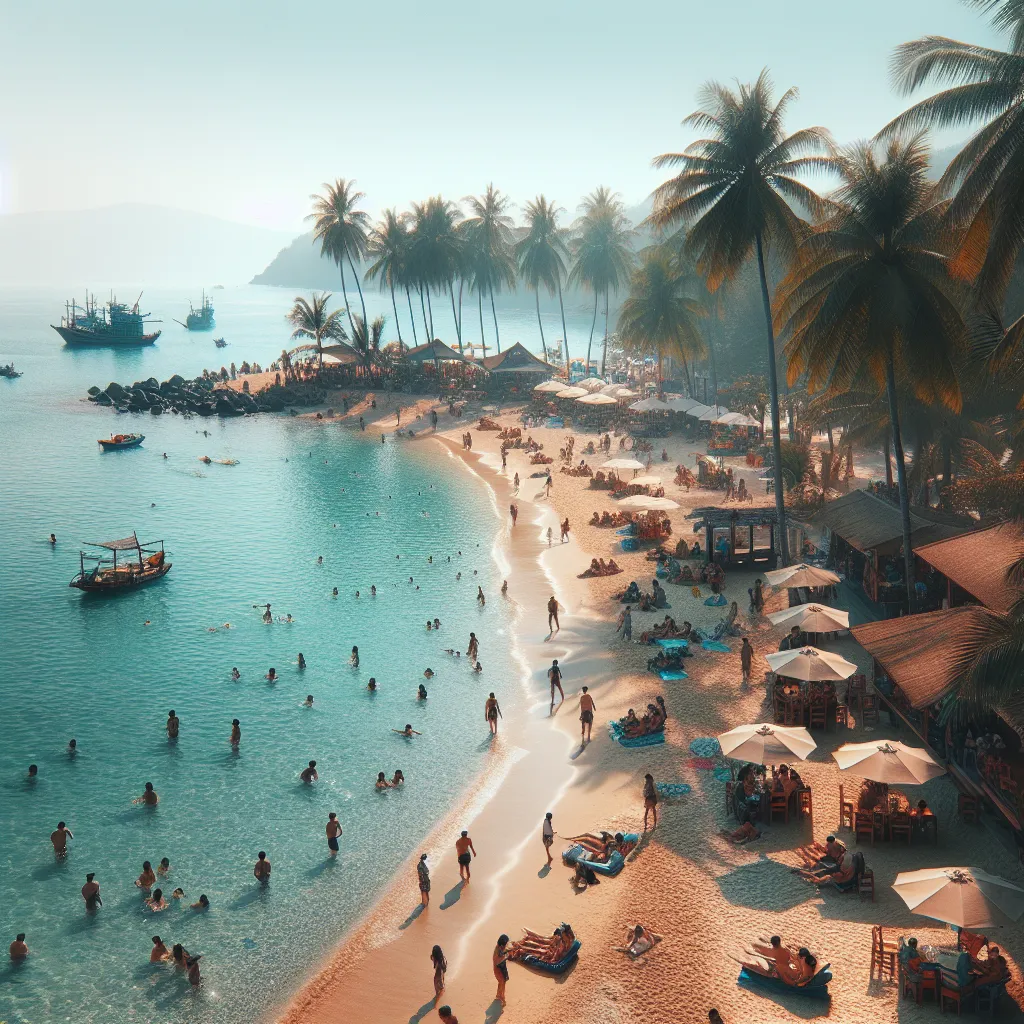The IELTS Speaking test often includes questions about places in your country, and describing a popular beach destination is a common topic. This article will guide you through answering such questions effectively, focusing on the prompt “Describe a place in your country that is popular for its beaches.” We’ll cover strategies for all parts of the speaking test and provide sample answers to help you achieve a high band score.
Understanding the Topic
Before we dive into the specifics, it’s important to understand why this topic is significant. Beaches are often key tourist attractions and can reflect a country’s natural beauty, culture, and economy. Being able to describe a popular beach destination showcases your ability to talk about geography, tourism, and local culture – all valuable skills in the IELTS Speaking test.
 Popular beach in Vietnam
Popular beach in Vietnam
Part 1: Introduction and Interview
In this section, the examiner may ask general questions about beaches and your experiences. Here are some possible questions:
- Do you like going to the beach?
- How often do you visit beaches?
- What do you usually do when you’re at the beach?
- Are there many beaches in your country?
Let’s look at a sample answer for the first question:
Examiner: Do you like going to the beach?
Band 6-7 Answer:
Yes, I do enjoy going to the beach. It’s a great place to relax and enjoy the sun. I like swimming in the sea and walking along the shore. The beach is also a nice spot for spending time with friends and family.
Band 8-9 Answer:
Absolutely, I’m quite fond of beach trips. There’s something inherently relaxing about the combination of sun, sand, and sea. I find the sound of waves incredibly soothing, and I relish the opportunity to engage in various activities like swimming, beach volleyball, or simply basking in the sun. Moreover, beaches often provide a perfect backdrop for quality time with loved ones or for some peaceful solitude.
Part 2: Long Turn (Cue Card)
Here’s a sample cue card related to our topic:
Describe a place in your country that is popular for its beaches.
You should say:
- Where it is located
- What features make it popular
- What activities people can do there
- And explain why you think it is a popular destination
Sample Answer (Band 6-7):
I’d like to talk about Nha Trang, a coastal city in central Vietnam that’s famous for its beaches. It’s located in Khanh Hoa province, about 450 kilometers north of Ho Chi Minh City.
Nha Trang is popular because of its beautiful long stretches of sandy beaches and clear blue water. The city has a nice climate most of the year, which attracts many tourists. The main beach is very clean and well-maintained, making it a great place to relax.
Visitors to Nha Trang can enjoy many activities. Swimming and sunbathing are the most common. People can also try water sports like jet-skiing and parasailing. There are boat trips to nearby islands where you can go snorkeling or scuba diving to see the coral reefs.
I think Nha Trang is popular because it offers a good mix of natural beauty and modern facilities. The beaches are beautiful, but the city also has good hotels, restaurants, and nightlife. It’s a place where people can relax on the beach during the day and enjoy city life in the evening. This combination makes it attractive to both Vietnamese and foreign tourists.
Sample Answer (Band 8-9):
I’d like to draw your attention to Nha Trang, a picturesque coastal city situated in central Vietnam, specifically in Khanh Hoa province, roughly 450 kilometers north of Ho Chi Minh City.
Nha Trang has garnered immense popularity due to its stunning coastline, characterized by expansive stretches of pristine sandy beaches and crystal-clear turquoise waters. The city is blessed with a favorable climate for the majority of the year, which serves as a major draw for tourists. The main beach, in particular, is meticulously maintained, offering visitors an idyllic setting for relaxation.
Visitors to Nha Trang can indulge in a plethora of activities. Beyond the quintessential beach pastimes of swimming and sunbathing, the city offers an array of exhilarating water sports, including jet-skiing and parasailing. Additionally, boat excursions to nearby islands provide opportunities for snorkeling and scuba diving, allowing tourists to marvel at the vibrant coral reefs teeming with marine life.
In my opinion, Nha Trang’s popularity stems from its unique blend of natural allure and modern amenities. While the breathtaking beaches serve as the primary attraction, the city also boasts a well-developed tourism infrastructure, including world-class hotels, diverse culinary options, and a vibrant nightlife scene. This harmonious coexistence of natural beauty and urban conveniences creates an appealing destination that caters to a wide spectrum of preferences, enticing both domestic and international tourists alike.
Examiner: What challenges does this popular beach destination face?
Band 6-7 Answer:
I think Nha Trang faces some challenges due to its popularity. One issue is overcrowding, especially during peak tourist seasons. This can lead to problems like pollution on the beaches and in the sea. Another challenge is maintaining the natural beauty of the area while developing tourism facilities. The local government needs to find a balance between growth and preservation.
Band 8-9 Answer:
Nha Trang, like many popular tourist destinations, grapples with several challenges stemming from its success. Foremost among these is the issue of overcrowding, particularly during peak seasons, which puts considerable strain on local resources and infrastructure. This influx of visitors can lead to environmental degradation, including beach erosion and marine pollution, potentially jeopardizing the very natural beauty that attracts tourists.
Moreover, there’s a delicate balance to be struck between tourism development and environmental conservation. The rapid expansion of hotels and resorts along the coastline risks encroaching upon natural habitats and altering the landscape. Local authorities face the daunting task of implementing sustainable tourism practices to mitigate these impacts while still fostering economic growth.
Another significant challenge is maintaining authenticity. As Nha Trang becomes increasingly tailored to tourist preferences, there’s a risk of losing its unique local character and culture. Striking a balance between catering to international visitors and preserving local traditions is crucial for the long-term sustainability of Nha Trang as a tourist destination.
Part 3: Two-way Discussion
In this part, the examiner will ask more abstract questions related to the topic. Here are some possible questions and sample answers:
Examiner: How has tourism affected coastal areas in your country?
Band 6-7 Answer:
Tourism has had both positive and negative effects on coastal areas in Vietnam. On the positive side, it has brought economic benefits, creating jobs and improving infrastructure in many coastal towns. However, it has also led to some problems like overcrowding and pollution. Some beaches have become too busy, and there are concerns about damage to marine ecosystems. The government is trying to manage these issues to make tourism more sustainable.
Band 8-9 Answer:
The impact of tourism on Vietnam’s coastal regions has been multifaceted and profound. On the positive side of the ledger, tourism has been a significant economic driver, stimulating job creation and catalyzing infrastructure development in numerous coastal communities. This economic boost has elevated living standards for many locals and put previously obscure locations on the map.
However, this growth has not been without its drawbacks. Many coastal areas are now grappling with the challenges of overtourism, including environmental degradation, strain on local resources, and the erosion of cultural authenticity. The influx of visitors has led to increased pollution, both on beaches and in marine ecosystems, threatening biodiversity and the long-term viability of these natural attractions.
Moreover, there’s a growing concern about the sustainability of rapid coastal development. The proliferation of resorts and tourism infrastructure often comes at the expense of natural habitats and traditional ways of life. This has sparked a debate about finding a balance between economic development and environmental conservation.
In response, there’s been a shift towards more sustainable tourism practices. The government and some private sector entities are implementing measures such as limiting visitor numbers to sensitive areas, promoting eco-tourism, and investing in waste management systems. The goal is to harness the economic benefits of tourism while preserving the natural and cultural heritage that makes these coastal areas attractive in the first place.
Key Vocabulary and Phrases
To achieve a high band score, it’s crucial to use a range of vocabulary accurately. Here are some key terms and phrases related to describing beaches and tourism:
-
Picturesque (adjective) /ˌpɪktʃəˈresk/ – visually attractive, especially in a quaint or charming way
Example: The picturesque coastline attracts photographers from around the world. -
Pristine (adjective) /ˈprɪstiːn/ – in its original condition; unspoiled
Example: The island boasts pristine beaches untouched by mass tourism. -
To marvel at (phrasal verb) /ˈmɑːrvəl æt/ – to be filled with wonder or astonishment
Example: Visitors marvel at the crystal-clear waters and diverse marine life. -
Breathtaking (adjective) /ˈbreθteɪkɪŋ/ – astonishing or awe-inspiring in quality, so as to take one’s breath away
Example: The sunset over the ocean provides a breathtaking view every evening. -
To grapple with (phrasal verb) /ˈɡræpəl wɪð/ – to struggle or contend with
Example: Coastal communities are grappling with the challenges of sustainable tourism.
Examiner’s Advice
To excel in the IELTS Speaking test when describing a popular beach destination:
- Be specific: Provide detailed information about the location, features, and activities available.
- Use varied vocabulary: Incorporate a range of descriptive adjectives and specific terms related to beaches and tourism.
- Discuss pros and cons: Show critical thinking by addressing both positive and negative aspects of tourism in coastal areas.
- Provide examples: Support your points with specific examples or personal experiences if possible.
- Practice fluency: Work on speaking smoothly and confidently, minimizing hesitations and fillers.
Remember, the key to success in the IELTS Speaking test is not just about what you say, but how you say it. Practice regularly, record yourself, and listen back to identify areas for improvement.
For more tips on IELTS Speaking, you might find these articles helpful:
- Describe a place in your country that you would like to explore
- How to deal with the environmental impact of tourism
By following these guidelines and practicing regularly, you’ll be well-prepared to discuss popular beach destinations and other topics in your IELTS Speaking test.


